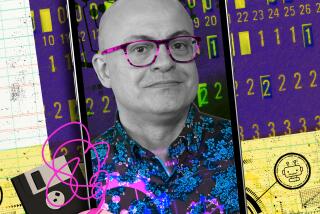DISCOVERIES
- Share via
GUILTY OF DANCING THE CHA CHA CHA, By Guillermo Cabrera Infante, Translated from the Spanish by the author, Welcome Rain Publishers: 112 pp., $22.95
Three stories that share the same space at the same time are, Guillermo Cabrera Infante explains, “an impossibility in physics but not in fiction.” They comprise a triptych, set in a Cuban restaurant at the end of the 1950s. The city? Of course, Havana. The first moves to the music of a Santeria ritual, the second to the bolero and the third to the cha-cha-cha. In each, the man and the woman eat in a restaurant. It is raining outside. The man wonders whether he will marry the woman.
The Santeria theme in the first draws the two characters together against its deep, dark background. In the second, the bolero makes the rhythm of their dialogue sharper and crueler: It is all about contrast, male female, light dark. The third, the cha-cha-cha, is more about the “we.”
The man in the stories carries the book of his life, which he periodically asks the woman to open in order to explain her behavior. The world outside the lovers is different in each, though it is the same city, like a dream dreamed in different houses or a play performed with different sets. The first two are heavy with nostalgia; the third is set in a more modern, more politically confused Cuba. Together, they have the feel of an exercise undertaken by a master.
*
HAPPENING, By Annie Ernaux, Seven Stories Press: 96 pp., $18.95
A friend once told me that he had a lover who repeatedly accused him of “feeling too much.” We laughed about this, nervously, like patients at the dentist with an uncertain number of exposed nerve endings. Annie Ernaux is not afraid of feelings. She writes like a general in command of a vast army of feelings. “You! Step forward,” she commands of anger. “Attention!’ she hollers at sadness. “Forward march!” she gestures grandly at righteousness. Feelings? I got ‘em! In “Happening,” Ernaux marches her army toward memory, the memory of an abortion she had in 1963. She was 23; abortion in France was illegal, immoral and, above all, dangerous. A doctor could lose his or her practice just speaking about it, and a woman could be arrested. Ernaux struggles to remember what it was like trying to perform the abortion herself with a knitting needle; asking a doctor for help and being rejected; going to a crone-midwife and having a probe inserted in her uterus; and finally, with the help of a friend, miscarrying, cutting the cord of the three-month fetus and being admitted to the hospital because she was hemorrhaging.
Ernaux saves specifics for the description of feelings, a unique aspect of her unsentimental insistence of the political relevance of women’s instincts and emotions. “One week later Kennedy was assassinated in Dallas,” she writes of the revelation in 1963 that she was pregnant. “By then I had lost interest in that sort of thing.” Blasphemy! If I cowered in the face of this task, she writes of the memoir, “I would be guilty of silencing the lives of women and condoning a world governed by male supremacy.” What does she offer as proof? She writes of her account of the abortion, “the only evidence I have stems from the lingering sensations of people and things outside of me.” Confronting her memories brings revelation: “I killed my own mother inside of me,” she writes, and later, “I realized I was through with religion.” Been accused lately of being too sensitive? Ernaux is your medicine!
*
VENICE REVEALED, An Intimate Portrait, By Paolo Barbaro, Steerforth Press: 240 pp., $25
Leave aside for the moment the question of whether or not you can or can’t go home again. Consider the tribal affinities of people who grew up in cities: their hometown newspaper, the question of morning coffee and how it is prepared, those corners and piazzas known only to a city’s citizens, the stress levels of its women, the way sounds of workmen reverberate through its streets. A childish happiness is built on these details, as well as a lifetime hankering for the cities we were born in. Paolo Barbaro does go back to Venice, the city he grew up in, and yes, it is not the same as the city he left seven years ago. The population has dwindled by more than half in five years, leaving only 70,000 people in the city. Offices have been liquidated, and industries like metal working, mosaics, cotton weaving and painting are gone, leaving streets named after them. Restaurants are now painted white, not the traditional Venetian red. But the sirens still signal high tide; the women or venexiane, are too sacred, too beautiful to speak of; the famous Venetian irritability is as unavoidable as the winds. It is a city built on millions of tree trunks. Once home, Barbaro writes, “We don’t ever want to leave again.”
More to Read
Sign up for our Book Club newsletter
Get the latest news, events and more from the Los Angeles Times Book Club, and help us get L.A. reading and talking.
You may occasionally receive promotional content from the Los Angeles Times.







